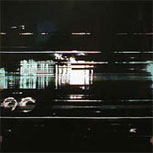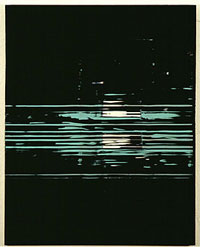Responses to Bill Davenport’s Tire Iron 6: John Pomara, at Inman Gallery:
Bill Davenport makes some good points and observations about John Pomara’s work. I have a couple of quibbles, and a thing or two to add. First, when I read that something is “competent, affectless, and impersonal,” my first question is, why? I wish Davenport had gone more into the reasons a painter might deliberately work that way.
My own theory is that many painters are still drawn to “the gesture,” an unplanned, frequently exhilirating way of generating visual information, but are sick of the romantic action-painter myth left over from the “50s. The use of squeegees — or in Pomara’s case, customized “painter’s shields” — to blur and scrape away paint is a way of literally “eradicating the gesture,” but also adding another exciting, randomizing variable in the creation of a picture.
This new variable suggests fresh content: the “impersonality” and “affectlessness” of the times, yes, but also a reference to the new visual landscape given to us by technology — “intermittent, static-laden signals on the information superhighway,” as Davenport nicely puts it. There are plenty of interesting artists working in this territory: Stephen Ellis, John Zinsser, Bill Komoski, Shirley Kaneda, Mark Sheinkman, William Wood, Carl Fudge, Rochelle Feinstein, to name a few. Instead of the somewhat belittling ‘squeegee school,” a better term would be “mediated abstraction,” referring to media in both the material and communications sense. This is an international tendency among painters, which both Pomara and Griffin are aware of and plugged into. And which, I might add, Pomara continues to work and evolve in.
If we must compare Pomara and Griffin, a better job could be done. “Griffin is a man imitating a machine,” Davenport says, while Pomara is “a painter using mechanical techniques to depersonalize his pictures.” isn’t that a distinction without a difference? I’d say Pomara, with his succulent surfaces and all-too-human imperfections, is a man imitating a machine, while Griffin, with his high-polished control of every millimeter of a picture, is more like a machine imitating a man. (And I mean that in a good way.)
– Tom Moody, New York************************

It’s a fact: John’s work is not impersonal to him, and certainly not unemotional.
It is sometimes read as impersonal by others, perhaps, because it uses an abstract language.
It is easier to think of art made with recognizable things or images or language as more communicative, and thus more engaging for some viewers.
John talks mostly to himself, with shadows and flashes, and some of us like to listen in from time to time.
It is easy to think of something that looks handmade as more personal.
Bill Davenport’s work is handmade.
But so is John’s.
As symbolic communication, Bill’s work often says “personal” and “quirky” and John’s often says “impersonal” and ‘systematic.”
A ragged out sweater. A microfiber tube top. Humans inside both. Some will get off to one, some the other, some both.
The savvy viewer can see that both artists make personal art.
They are just two people, subjectively interested in two different kinds of discourse.
– Jeff Dalton




